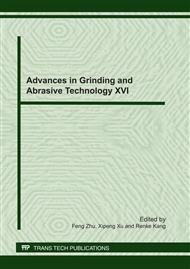p.189
p.195
p.199
p.204
p.209
p.215
p.220
p.225
p.229
Simulation of Grinding Wheel with Random Three-Dimensional Abrasive and Microporous Bond
Abstract:
Be different from traditional simulation modeling method, in this paper, a random shape and distribution polyhedrons abrasive modeling method has been developed which simulation model is similar to the grinding wheel surface topography. Imitated the industrial process of abrasive production cutting, the characteristics of random distribution in the space and anisotropic of the abrasive particle shape on grinding wheel surface was also considered. A random geometry abrasive solid simulation model was developed which used random segmentation plane. Simulation modeling of grinding wheel in the past often overlooked component accounts for a large volume of wheel porous factors. Therefore, this article considered the random shape and position of the distribution of the abrasive and porous in grinding wheel bond of the simulation model, a random abrasive shape and porous distribute model was founded. It provides a meaningful model for the depth study of three-dimensional grinding simulation technology. Finally, grinding simulation results verified the reliability of the model.
Info:
Periodical:
Pages:
209-214
Citation:
Online since:
July 2011
Authors:
Keywords:
Price:
Сopyright:
© 2011 Trans Tech Publications Ltd. All Rights Reserved
Share:
Citation:


